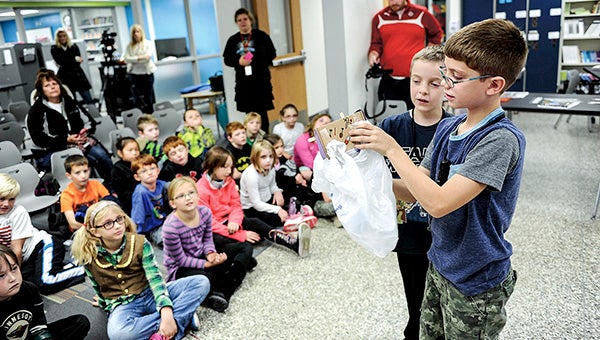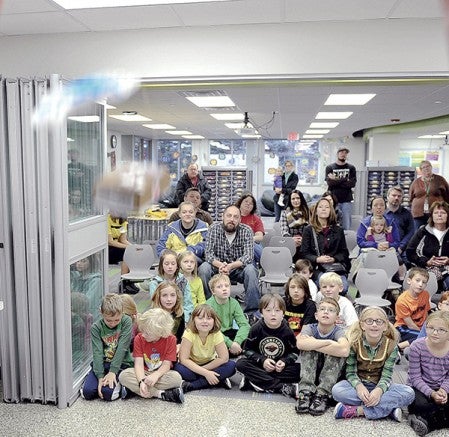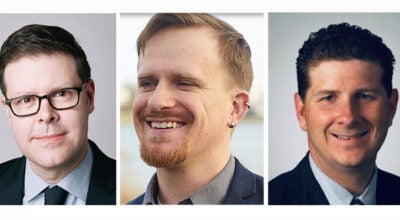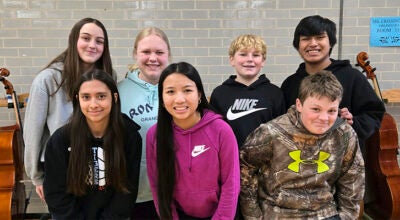Administering airdropped aid: Pi Academy students use simulation to learn about helping other countries
Published 6:01 am Sunday, November 1, 2015

Sean Marks, right, and James Ekins describe their air drop project Friday morning at the Pi Academy at Southgate Elementary school. Eric Johnson/photodesk@austindailyherald.com
Southgate Elementary School students in the Pi Academy got the chance to administer aid to Thailand Friday — at least in simulation.
“We’re doing aid-drop packages, because people in Thailand, sometimes their cities get flooded and then they can’t get to the other cities to get the things they need,” Alex Rezny, 10, said. “So airplanes and helicopters and stuff, they have to drop things from the air onto the ground. And so we need to have it so there’s no damage, it communicates what’s inside and it’s easy to see where they drop it.”
Students have been using the Engineering Adventures curriculum to explore and work with the engineering design process. As part of their current unit, Package Engineering, students have explored many types of packaging materials and how they work together.
As a capstone to the unit, students built a package containing noodles and marbles as part of a simulation to air drop aid packages to a country after a natural disaster. Friday, they tested their simulations of a drop package to the class and parents.
“We’ve practiced the last few weeks on different types of materials that would protect the food and the water supplies,” Pi Academy teacher Karla Carroll said. “So they’ve each been able to design their own aid-drop package, so today is the final test to see whether they succeeded.”
Alex was excited to test his simulation out.
“Me and my partner, we did a box with pompoms in it, covered by foam with a canopy in the parachute,” he said. “A bit complicated but it gave us no damage [during practice].”
The program used the engineering design process, and during the simulation students had to communicate with their partner and other people in the class.

Parents and students watch as a package is dropped at Southgate Elementary’s Pi Academy Friday morning. Students were tasked to come up with a plan to simulate an air drop of aid to another country during a natural disaster. Eric Johnson/photodesk@austindailyherald.com
“They’re working in a collaborative way to solve an open-ended question or problem that has multiple solutions,” Carroll said. “And so you won’t see any package that’s the same as anyone else’s, because they’re able to use creativity to come up with their own package.”
She said the students have been totally engaged during the process.
For Grace Anderson, 9, and her two partners, their project saw no damage when one of their teachers dropped it off the tall ladder.
“We put in, like, a box, and then we had string, and then we had a paper plate so it would almost be like a parachute but it was a canopy,” Grace said. “And then we had a box and we put foam all over and we flipped it over and put foam inside.”
The team also color coded the sides to make it easier to see when dropped, and labeled the box with water, food, medicine and more.
“We thought those were probably the most important things,” she said.
Carroll hoped the students would better understand problem solving, the planning process to solve a problem and that not all issues are solved the same way.
“I hope they continue to work on their communication skills and work in a collaborative way,” she said. “That they can give some ideas and take other people ideas and put them together to make a better product than they could have done on their own.”
The class is already thinking about the future, and Carroll said there is a packaging engineer coming to the class soon to talk about her career.
“Hoping that what they’ve learned in this engineering unit, she’s going to connect what she does for her career,” Carroll said. “So we are looking to the future.”
She said the students had a good time creating the aid-drop packages, and although they had some challenges, it was a worthwhile project.
“The kids have just done a really good job and they’ve worked really hard for today, so that’s exciting to see how excited they are for this,” she said.





